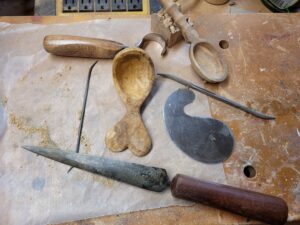One of my new endeavors is spoon carving. A spoon is a perfect little sculpture, just a bowl and a handle. They can be made on the lathe, but I prefer to carve mine from a single piece of wood.
Carving a spoon is a meditative process. I study the wood looking for features that will play into a pattern or show off a facet. Wood for spoons should be hard, dense and close grained. Burl and grain patterns are important features that can be highlighted. When I have a design, the rough shape is usually cut out on a bandsaw, although I have a finger sized Japanese saw that I can use for delicate cuts. The next step is major wood removal with power tools. Anything from a 4 inch grinder with a mini chain saw attachment to a micro carver, a Dremel or a die grinder. Working from coarse to medium to fine, each successive pass refines the shape.
Between two thirds and three quarters of the time spent on a spoon is in the handwork. Starting with rasps to smooth out the lines and further refine the flow, following with files

and rifflers (love that name), finer and finer tools. When the work is in the final stages, I like to use a cabinet scraper to finish the surface. This tool can leave a perfectly smooth surface, with no sanding required. But that’s not possible on every piece and sanding may be necessary. Sanding, while not hard, is usually a multi-hour process in its own right.
I finish the spoon with several coats of Danish oil — a mixture of tung oil, shellac and mineral spirits. After the oil has had a few days to soak in and dry, it’s buffed out with an abrasive polish and oiled again, then polished. A small tray is created for the presentation, and often a card with details about the piece.